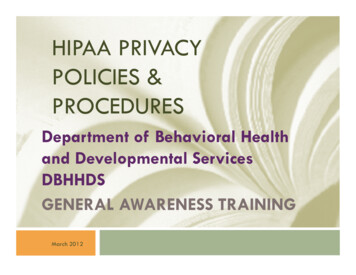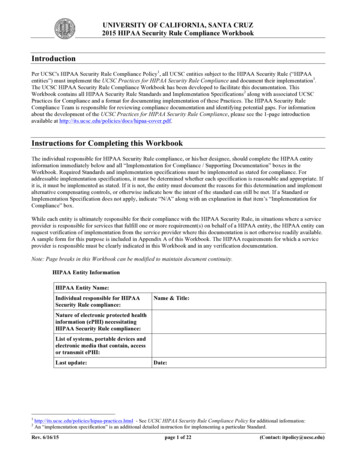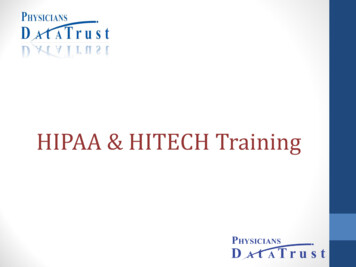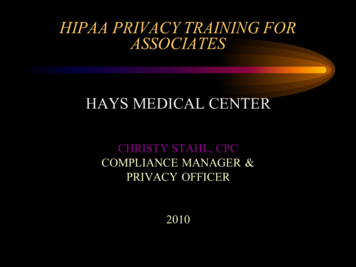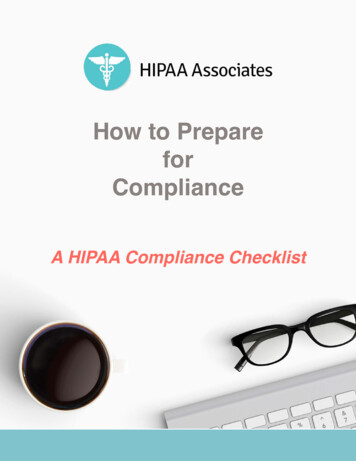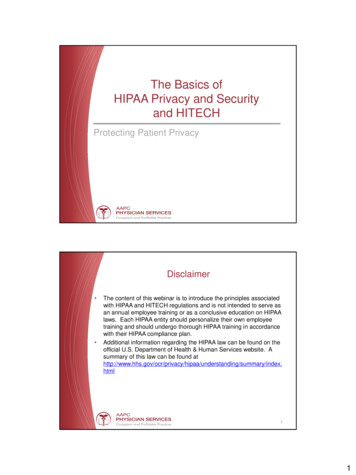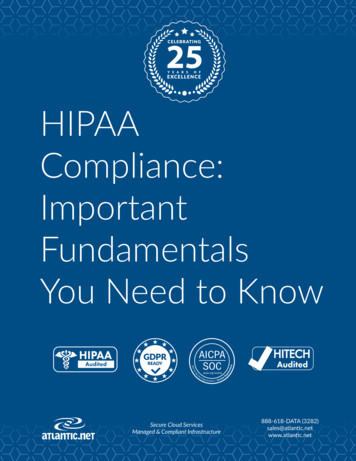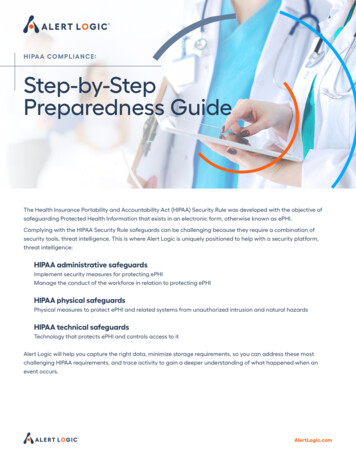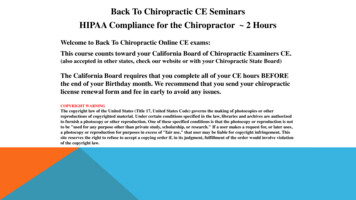
Transcription
Back To Chiropractic CE SeminarsHIPAA Compliance for the Chiropractor 2 HoursWelcome to Back To Chiropractic Online CE exams:This course counts toward your California Board of Chiropractic Examiners CE.(also accepted in other states, check our website or with your Chiropractic State Board)The California Board requires that you complete all of your CE hours BEFOREthe end of your Birthday month. We recommend that you send your chiropracticlicense renewal form and fee in early to avoid any issues.COPYRIGHT WARNINGThe copyright law of the United States (Title 17, United States Code) governs the making of photocopies or otherreproductions of copyrighted material. Under certain conditions specified in the law, libraries and archives are authorizedto furnish a photocopy or other reproduction. One of these specified conditions is that the photocopy or reproduction is notto be "used for any purpose other than private study, scholarship, or research." If a user makes a request for, or later uses,a photocopy or reproduction for purposes in excess of "fair use," that user may be liable for copyright infringement. Thissite reserves the right to refuse to accept a copying order if, in its judgment, fulfillment of the order would involve violationof the copyright law.
Exam Process: Read all instructions before starting!1. You must register/pay first. If you haven't, please return to: backtochiropractic.net2. Open a new window or a new internet tab & drag it so it's side-by-side next to this page.3. On the new window or new tab you just opened, go to: backtochiropractic.net website.4. Go directly to the Online section. DON'T register again.5. Click on the Exam for the course you want to take. No passwords needed.6. Follow the Exam instructions.7. Upon passing exam (70%), you’ll be able to immediately download your certificate,and it’ll also be emailed to you. If you don’t pass, you must repeat the exam.Please retain the certificate for 5 years. DON’T send it to the state board.If you get audited and lose your records, I’ll have a copy.I’m always a phone call away. 707.972.0047 or email: marcusstrutzdc@gmail.comMarcus Strutz, DCBack To Chiropractic CE Seminars33000 North Highway 1Ft Bragg CA 95437
zHIPAACOMPLIANCEfor theChiropractorMichelle Massa, DC, CEES
zIntroduction Education & Background Psychology, Lifestyle, Nutrition & Wellness Neuropsychology & Behavioral Psychology Health Education – Adult Weight ManagementHIPAA, Ethics and Law, History, Exam, Diagnosis & Documentation Compliance Officer – Life West Health CenterCertified Ergonomist Ergonomic Evaluations Ergonomic & Workplace Safety Trainingswww.MichelleJMassa.com
zGoals & Objectives Review HIPAA Have an adequate understanding of Protected HealthInformation & Accessibility Understand the components of a HIPAA compliant chiropracticoffice
zOverview HIPAA The Privacy Rule The Security Rule HIPAA according to Federal Regulations How to maintain a HIPAA compliant chiropracticpractice in the state of California
zWhat is HIPAA Health Insurance Portability and Accountability Act HIPAA Sets a National Standard To ensure both the proper access to and confidentiality of medical records,Congress enacted the Health Insurance Portability and Accountability Act of1996 (HIPAA). HIPAA is a federal law that establishes the rules for managing medicalinformation throughout the United States. Although states may adopt stricterconfidentiality rules, HIPAA sets the minimum standards and protections formedical privacy.HIPAA is a program designed by the federal government to ensure thatpatient’s health records are kept confidential
zWhat does HIPAA Protect Protects patients privacy Visual privacy Auditory privacy Prevents unauthorized access
zHIPAA History To improve the efficiency and effectiveness of the health care system,the Health Insurance Portability and Accountability Act of 1996 (HIPAA), Required HHS to adopt national standards for electronic health caretransactions and code sets, unique health identifiers, and security. At the same time, Congress recognized that advances in electronictechnology could erode the privacy of health information. Congress incorporated into HIPAA provisions that mandated the adoptionof Federal privacy protections for individually identifiable health information.
zHIPAA History HHS published a final Privacy Rule in December 2000, which was latermodified in August 2002. This Rule set national standards for the protection of individually identifiablehealth information by three types of covered entities: health plans, healthcare clearinghouses, and health care providers who conduct thestandard health care transactions electronically. Compliance with the Privacy Rule was required as of April 14, 2003 (April 14,2004, for small health plans).HHS published a final Security Rule in February 2003. This Rule sets national standards for protecting the confidentiality, integrity, andavailability of electronic protected health information. Compliance with theSecurity Rule was required as of April 20, 2005
zCovered Entities HIPAA's privacy and security rules must be followed by"covered entities." These include any person or businessthat provides, bills, or receives payment for medical care,including: health care providers clearinghouses that process (change the format of) medicalinformation health plans and health insurance issuers
zBusiness Associates HIPAA also covers "business associates" who haveaccess to health care information from covered entities. "Business associates" are individuals and organizations(including contractors and other non-staff) who performcertain services and activities, such as: claims processing and third-party billing administrative, management, and professional consulting data transmission, storage, and aggregation (including web-hosting)
zThe Privacy Rule The HIPAA Privacy Rule: protects individually identifiable health information requires organizations to establish safeguards toensure medical privacy restricts the use and disclosure of medical information gives patients the right to access and control theirmedical records
zThe Privacy Rule The HIPAA Privacy Rule requires organizations to: adopt privacy policies and procedures notify patients and clients about their privacy rights institute safeguards to secure Protected Health Information (PHI) train staff (employees and volunteers) on their responsibility for privacy appoint a Privacy Officer responsible for enforcing privacyrequirements set up procedures to respond to complaints about privacy take steps to minimize any unauthorized access or use of PHI
zThe Privacy Rule The Privacy Rule protects health information from the time arecord is created (or the information is revealed) to the time it'sdestroyed. Generally, covered entities and business associates may notuse or release an individual's medical information unless thePrivacy Rule expressly permits it, or the individual authorizes it. And when medical information may be shared, the Privacy Rulestrictly limits the amount of information that may be provided.
zThe Privacy Rule The Privacy Rule does not forbid all disclosures ofmedical data. For example, there are almost norestrictions on providing information to: the patient someone authorized by the patient a health care professional treating the patient
zProtected Health Information (PHI) Because HIPAA is designed to protect personal privacy, the Privacy Ruleapplies to any "individually identifiable health information." Thus, any information or record, in any form or media (including electronic,paper, or oral), about an individual's mental or physical health, condition, ortreatment (whether past, present, or future), should beconsidered Protected Health Information (PHI).
zDe-Identified PHI De-Identified PHIOne way to avoid HIPAA's limitations (and simultaneouslyprotect patients' privacy) is to "de-identify" medical records orother PHI. For example, PHI can be de-identified by taking out all informationthat can be linked to any individual; the remaining data is then deidentified.
zMinimum Necessary The Privacy Rule generally requires covered entities totake reasonable steps to limit uses, disclosures, or requests (ifthe request is to another covered entity) of protected healthinformation (PHI) to the minimum necessary to accomplish theintended purpose.
z Protected Health Information (PHI)According to HIPAA, medical records and data are PHI when they contain "individualidentifiers" such as: names contact information (street or email address, telephone or fax number) dates directly relating to an individual (birth or death, admission or discharge) geographic subdivisions smaller than a state (county, city, zip code) account numbers (Social Security, medical record, insurance) biometric identifiers (fingerprint, retinal scan, full-face photograph) other unique identifiers (certificate or license number, vehicle license plate, WebURL, IP address)By contrast, if information doesn't relate to specific people (such as a hospital's annualoccupancy rate), it probably isn't PHI.
zAccessibility and Authorized Disclosures Although HIPAA ordinarily restricts sharing healthinformation, it requires organizations to disclose PHIin two situations: when an individual (or their personal representative)requests their own information to respond to investigations by the Department ofHealth & Human Services
z Patient Requested RestrictionsHIPAA also allows individuals to request restrictions on future uses of their PHI. Basically,patients can ask to limit the type or amount of information an organization will provide. Forexample, a patient may ask: that certain relatives not be informed about the patient's condition for communications to alternative or specific addresses (that bills be sent to a postoffice box, or that calls be made to a cell phone rather than to a home telephonenumber) for confidential communications (appointment reminders mailed in a sealed enveloperather than a post card, or that no messages be left on an answering machine) that health plans not be told about treatments if the patient pays for the service in full for other specific restrictions on the use of their PHI
z Individual RightsHIPAA also gives individuals control over their own PHI, including the right to: access their PHI obtain copies of their PHI (including electronic records) within 30 days request amendments to correct or complete their records request confidential communications obtain an accounting of who used or received their PHI impose restrictions on disclosure of their PHI under certain conditions opt out of fundraising communications revoke previous authorizations file complaints
zIncidental Disclosures HIPAA requires organizations to protect medical privacy. However, even withprecautions, there is always the possibility of an "incidental" disclosure. Still, it's important to be aware of the risk of (and guard against) incidentaldisclosures. For example: speak quietly when discussing patients or health care in public areas(waiting room, hallways, elevators) avoid using patients' names in public areas use a private office when authorized to discuss PHI on the telephone don't leave health care records or files where they're visible to others
zHow can you Protect PatientConfidentiality Minimize Incidental Disclosures Sign in Sheets Check in line/Check out Line Limit discussions in waiting rooms Stay away from specific conversations in hallways Speak in low tone in open areas Telephone practices
zSecurity Rule The Security Rule applies to health care information (including handlingclaims or determining eligibility) involving electronic data: in transit across the Internet, intranet, and wireless networks downloaded to a smartphone, tablet, or other mobile device at rest in electronic media such as magnetic tape, disks, CDs, etc. in use while electronic records are created, updated, or retrieved being destroyed (e.g., disks being erased, recycled, or disposed of)The Security Rule even applies when E-PHI is moved physically, suchas when someone carries around a disk, flash drive, or a laptopcomputer.
z Electronic Protected Health Information(E-PHI)The Security Rule applies to health care information (including handling claims ordetermining eligibility) involving electronic data: in transit across the Internet, intranet, and wireless networks downloaded to a smartphone, tablet, or other mobile device at rest in electronic media such as magnetic tape, disks, CDs, etc. in use while electronic records are created, updated, or retrieved being destroyed (e.g., disks being erased, recycled, or disposed of)The Security Rule even applies when E-PHI is moved physically, such as whensomeone carries around a disk, flash drive, or a laptop computer
zElectronic Protected Health Information(E-PHI) The Security Rule requires organizations to implement safeguards for electronicProtected Health Information (E-PHI), including: Administrative safeguards, such as assigning responsibility for security andappointing a "Security Official," adopting procedures to prevent and correct securityviolations, providing security training to staff, and disciplining staff for security policyviolations. Physical safeguards, which are methods to protect data, equipment, and the facilityagainst physical hazards (backing up data off-site and requiring laptops to be lockedwhen not in use) and to prevent unauthorized use or intrusion (locking office doors,and erasing disks before reusing them). Technical safeguards, which are primarily automated procedures to track and reduceunauthorized access (computer log-in and automatic log-off procedures, requiringspecial verification procedures for offsite/remote log ins, and authentication controlsensuring data encryption during transmission).
zHow to Make Web-Forms HIPAA Compliant Some of the more popular web-forms on the market includeJotForm, Ninja Forms, WuFoo, Gravity Forms, and ContactForm 7. Several of these forms are WordPress plug-ins and extensionsthat allow users to place web-forms directly onto their site. You won’t find HIPAA compliant online forms, but you can usethese services in a manner that conforms to HIPAA regulation.
zHow to Make Web-Forms HIPAA Compliant First and foremost: ask your web-form service if they’ll sign a Business AssociateAgreement to legally protect your patients’ data. Make sure that you’re creating encrypted forms. Encryption allows you to keep data more secure. Encrypted web-forms will guardany data entered into them so that they can only be accessed by entering a key. End-to-end encryption is the most secure and should be your preferred choice.
zHow to Make Web-Forms HIPAA Compliant Regularly download encrypted data, store it on a secure internal server, andthen delete the data from the web-form’s servers. Always logout of your web-form service when you’ve completed yoursession. By implementing these important privacy and security measures whenaddressing HIPAA for web-forms, you’re making a step toward protectingpatients’ PHI.
zHIPAA formso Notice of Privacy Practiceso Patient Acknowledgement/Receipt of the Noticeo Business Associate Agreemento Consent Formo Authorization Formo Fax Cover Sheeto Media Consent Form
zPrivacy Practices Notice Besides protecting medical privacy, HIPAA also requiresorganizations to notify individuals about their rights. Most organizations meet this requirement by distributing aPrivacy Notice. These notices must clearly explain: the organization's privacy practices and obligations how the organization may use and disclose PHI the organization's duty to provide notice about breaches of PHI(discussed later) the uses and disclosures of PHI that require authorization their rights to complain and whom to contact
zRecords and Logso At the ROF: “I love seeing my x-rays. Can I take a pictureof these on my phone?”o Maintain a log of all records releasedo Nameo Patient numbero Date requestedo Date processed/releasedo Where/WhooName, address, phone, fax, email
zCommunicationso Emailo Email communications are permitted, but you must take precautionso It is a good idea to warn patients about the risks of using email thatincludes patient health information (PHI)o Providers should be prepared to use email for certain communications, ifrequested by the patient, but must ensure they are not exposinginformation the patient does not want sharedo Providers must take steps to protect the integrity of information andprotect information shared over open networks
zEmail Communication sample Sample Email Confidentiality Notice WARNING:CONFIDENTIALITY NOTICE - The information enclosed withthis transmission are the private, confidential property of thesender, and the material is privileged communication intendedsolely for the individual indicated. If you are not the intendedrecipient, you are notified that any review, disclosure, copying,distribution, or the taking of any other action relevant to thecontents of this transmission are strictly prohibited. If you havereceived this transmission in error, please notify us immediatelyat (xxx) xxx-xxxx or xxxx@xxxxxxx.com.
zEmail & Text Communication sample Regulations require encrypted messaging systems forconfidential communications. Since our e-mail/textcommunications are not encrypted, it is the policy of [PracticeName] not to use e-mail/text for sharing confidential information.We are sorry if this causes inconvenience for you in receivinginformation from us. Please call us at (xxx)xxx-xxxx. Furtherinformation about our practice can be found on our website atwww.xxxxxxx.com If you have a medical emergency, please dial 911.
zoSocial Media and YelpOnlineooFacebook, Instagram, Twitter, etc.oUnderstand that even a deleted post can still exist in cyberspace.oSearch engines are constantly scouring all social channels, aggregating andstoring information to serve it up to anyone entering a search query. If a fewseconds pass between posting a comment and deleting it, the search enginemay have already come, picked up the information and gone.oUnderstand that even if a patient posts every last detail about his or hermedical issues and treatments, no medical professional or staff should repost,retweet or "regram" this information on their personal pages.YelpoAny acknowledgement HIPAA violation
zPatient Testimonials Create & Implement a HIPAA Media Release Form There may be certain circumstances where you wish to share a patienttestimonial or answer a question. It’s important to have the patient’s written consent before posting. If it is a video testimonial, know that the patient may rescindauthorization at any time. If it is photo of them with a statement regarding their condition, makesure you have the written authorization & know that the have the right torescind authorization at any time.
zHIPAA Sanctions HIPAA also specifically requires an employer to "applyappropriate sanctions against members of its workforce who failto comply with the privacy policies and procedures" [45 CFR§164.530(e)]. Thus, organizations are required by law todiscipline staff for violating HIPAA's privacy regulations.
z Case Example – Social MediaIn 2011, the Board of Nursing delivered a warning to a nurse who commentedon a small town newspaper’s blog. The nurse discussed a patient in positiveterms using a nickname. Even though she did not mention the patient’s realname or medical issue, mentions of his age and mobility aids made it clearwhich member of this small town the nurse was treating. HIPAA specifies 18items beyond just a patient’s name that must remain private. The nurseviolated the patient’s privacy rights, threatening her standing and position.
z Case Example – Social MediaIn an incident with particularly harsh repercussions, a student nurse moved byher three-year-old chemotherapy patient’s bravery took a photo of the boy andposted it on her Facebook page. Even though she had privacy settings inplace, another nurse not among that student nurse’s Facebook friends cameacross the post and photo. This nurse informed the hospital. This HIPAAviolation got the student nurse expelled from the nursing program and thenursing program bounced off of that hospital’s list of accepted schools fromwhich to draw student nurses. Even when motivated by the best intentions,HIPAA violations can result in severe consequences.
z Case ExamplesMinimum Necessary/ConfidentialCommunicationsA hospital employee did not observe minimum necessary requirements when she left atelephone message with the daughter of a patient that detailed both her medical conditionand treatment plan. An OCR investigation also indicated that the confidentialcommunications requirements were not followed, as the employee left the message at thepatient’s home telephone number, despite the patient’s instructions to contact her through herwork number. To resolve the issues in this case, the hospital developed and implementedseveral new procedures. One addressed the issue of minimum necessary information intelephone message content. Employees were trained to provide only the minimumnecessary information in messages, and were given specific direction as to what informationcould be left in a message. Employees also were trained to review registration information forpatient contact directives regarding leaving messages. The new procedures wereincorporated into the standard staff privacy training, both as part of a refresher series andmandatory yearly compliance training.
zCase Examples – Access A patient alleged that a covered entity failed to provide himaccess to his medical records. After OCR notified the entity ofthe allegation, the entity released the complainant’s medicalrecords but also billed him 100.00 for a “records review fee” aswell as an administrative fee. The Privacy Rule permits theimposition of a reasonable cost-based fee that includes only thecost of copying and postage and preparing an explanation orsummary if agreed to by the individual. To resolve this matter,the covered entity refunded the 100.00 “records review fee.”
z Case Examples – Uses & DisclosuresA public hospital, in response to a subpoena (not accompanied by a court order),impermissibly disclosed the protected health information (PHI) of one of its patients.Contrary to the Privacy Rule protections for information sought for administrative or judicialproceedings, the hospital failed to determine that reasonable efforts had been made toinsure that the individual whose PHI was being sought received notice of the request and/orfailed to receive satisfactory assurance that the party seeking the information madereasonable efforts to secure a qualified protective order. Among other corrective actions toremedy this situation, OCR required that the hospital revise its subpoena processingprocedures. Under the revised process, if a subpoena is received that does not meet therequirements of the Privacy Rule, the information is not disclosed; instead, the hospitalcontacts the party seeking the subpoena and the requirements of the Privacy Rule areexplained. The hospital also trained relevant staff members on the new procedures.
zA HIPAA Compliant Office Training of Staff/Faculty/Interns Physical Security Measures Confidentiality Agreements with all businessassociates
zConclusion
zToday’s Take-aways A HIPAA compliant chiropractic office: Measures in place to protect PHI Encrypted communications Appropriate forms
zKeep in Touch Michelle J Massa, DC, CEES www.MichelleJMassa.com Email: michellemassadc@gmail.com Facebook: Michelle Massa Facebook Page: Michelle J Massa, DC, CEES Linked in: Michelle J. Massahttps://www.linkedin.com/in/michellejmassadc Instagram: @MichelleJMassa
Thanks for taking Online Courses with Back To Chiropractic CE Seminars.I hope you enjoyed the course. Please feel free to provide feedback.Check out: Back To Chiropractic Resource PagesChiropracticpedia Informational website for chiropractic patientsFree Materials Over 200 files: Posters, newsletters & moreAdjusting & Office Skills Free help from DCs that careDCs Looking For DCs Looking to hire, or for a job?Chiropractic NeurologistsClassifieds Looking to buy or sell a PracticeMemorials Tributes to great DCs who have passedMarcus Strutz DCBack To Chiropractic CE Seminars33000 North Highway 1Ft Bragg CA 95437707.972.0047
1996 (HIPAA). HIPAA is a federal law that establishes the rules for managing medical information throughout the United States. Although states may adopt stricter confidentiality rules, HIPAA sets the minimum standards and protections for medical privacy. HIPAA is a program designed by the federal government to ensure that


